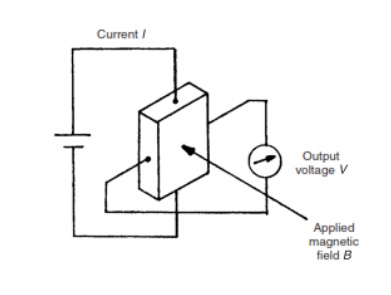Hall-effect transducers
Basically, a Hall-effect sensor is a device that is used to measure the magnitude of a magnetic field. It consists of a conductor carrying a current that is aligned orthogonally with the magnetic field, as shown in Figure 13.4. This produces a transverse voltage difference across the device that is directly proportional to the magnetic field strength. For an excitation current I and magnetic field strength B, the output voltage is given by V D KIB, where K is known as the Hall constant

The conductor in Hall-effect sensors is usually made from a semiconductor material as opposed to a metal, because a larger voltage output is produced for a magnetic field of a given size. In one common use of the device as a proximity sensor, the magnetic field is provided by a permanent magnet that is built into the device. The magnitude of this field changes when the device becomes close to any ferrous metal object or boundary. The Hall Effect is also commonly used in keyboard pushbuttons, in which a magnet is attached underneath the button. When the button is depressed, the magnet moves past a Hall-effect sensor. The induced voltage is then converted by a trigger circuit into a digital output. Such pushbutton switches can operate at high frequencies without contact bounce.

